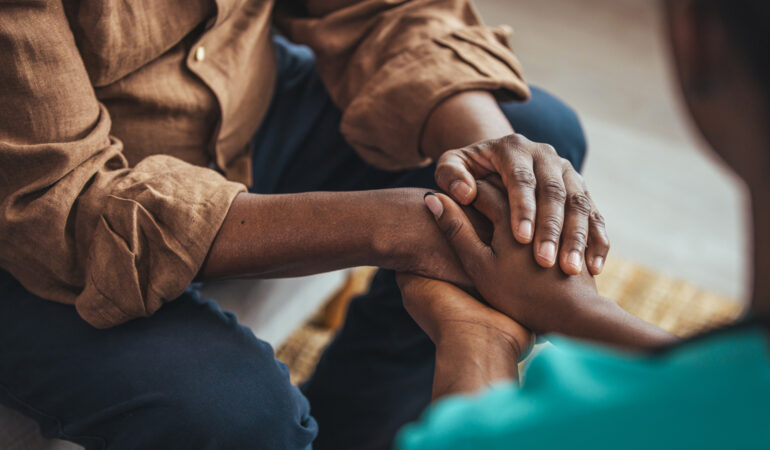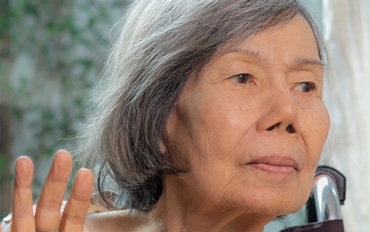Unlike most roles in life, caregiving may be thrust upon individuals when they least expect it. In 2024, there were 105.6 million caregivers in the United States (Farmer & Ramchand, 2024), and in 2020, there were over 53 million unpaid caregivers supporting friends and loved ones with chronic conditions or disabilities (Centers for Disease Control and Prevention, 2024). Twenty-four percent of caregivers provide care for two or more recipients. Sixty percent of these caregivers are women, and the median age of the caregivers is 51 years. Forty-eight percent of caregivers are between the ages of 18-49 while 34% of caregivers are 65 or older (American Association of Retired Persons & National Alliance for Caregiving, 2020). Caregivers spent an average of 25 hours every week providing care, and about 25% of them spend over 40 hours a week (Luker, 2023).
Along with this commitment to engage in caregiving, there is also a financial burden on caregiving. Ninety percent of caregivers offer financial support for their loved ones’ care. In 2025, an average family caregiver spends $7,200 a year on average out-of-pocket (American Association of Retired Persons, 2025), and collectively, they spend $600 billion annually on services for care recipients (Thomas, 2023). According to Gray (2024), 71% of caregivers are struggling financially, with 63% living paycheck to paycheck.
The journey of informal caregivers begins with receiving a diagnosis of their loved one to accepting their caregiving role and ultimately experiencing grief at the end of this journey (Sideman et al., 2022). This caregiving journey is influenced by the enrollment of the individual with a disability in a system of help within the community, the support of the family, and the intensity of illness or disability (Duconget, 2020). Most caregivers take on this responsibility due to filial obligations or religious beliefs (Anderson, 2012), often with little sense of agency or choice (Blake-Holmes, 2019), and report feeling unprepared or uninformed about the illness and thus did not know what to expect (Masterson-Algar & Williams, 2020). Therefore, they seek support but often do not receive it. Some caregivers are hesitant to use respite care services and hence have unmet respite care needs (Rehm, 2013).

These stressors put an increased burden on caregivers. The adverse effect on caregivers’ functioning due to the caregiving responsibilities is termed caregiving burden (Adelman et al., 2014). Empirical research has shown that caregiving can be a stressful experience that can impact the physical and psychological health of the caregiver (Schulz & Sherwood, 2017). Studies by Rehm (2013) reported that caregivers experience social isolation and often worry. Other studies expanded on his findings and reported that multiple stressors put caregivers, especially mothers, at a higher risk of developing clinical depression (Meltzer et al., 2010; Toly & Musil, 2015). Caregiver burden is related to poor mental health, while caregiver satisfaction is related to positive mental health (Prieto et al, 2022). Prieto and colleagues (2022) also reported that White caregivers had higher caregiver burden and lower caregiver satisfaction compared to Black/African caregivers or bi/multiracial caregivers.
The statistics around caregiving highlight the need for more discourse focused on developing structural and systemic interventions that can empower and support caregivers on this journey. We suggest clinicians begin by considering their own perceptions of ability/(dis)ability. Clinicians and clients can develop “a rejection of the notion that health or achieving able-bodiness should be the sole focus on disabled people’s lives at all times” (Kim & Schalk, 2021, p. 330). Clinicians and clients can explore literature about disability justice, which could decrease the desire to pity or develop a savior complex while working with caregivers. This countertransference may be unhelpful in our attempt to empower caregivers.
Considering the long-term nature of caregiving, clinicians may focus on building or increasing resiliency within caregivers and their families. However, we encourage clinicians to contextualize the client’s resilience before adding it to a treatment plan. Resilience can be defined as the “ability to withstand and rebound from crisis and prolonged adversity” (Walsh, 2015, p. vi). While resilience may be necessary for successful therapeutic outcomes, individuals may be tired of experiencing adversity and tired of needing to be resilient. Continuously focusing on hope, growth, or change could come across as toxic positivity. Clinicians can give caregivers the space to acknowledge the fatigue that comes with being resilient, while also acknowledging societal and interfamilial factors that contribute to adversity. Relational justice and ethical accountability from Contextual Therapy can be used to discuss clients’ feelings about the current state of healthcare. It is not fair that resilience also encompasses surviving the potential financial cuts to programs and organizations that provide relief to caregivers. For temporary relief, clinicians can have clients engage in a mental respite by allocating 5 to 10 minutes once or twice a week to mentally giving up the responsibility of caregiving.
Clinicians may want to acknowledge the strength required in individuals accepting a caregiving role and inquire about the strengths and coping strategies that the caregivers see in those for whom they are caring. Caregivers and those they care for display tremendous resilience as they encounter ableism. Periodically, it may be helpful for clinicians to remind caregivers of this resilience. It can be easy to take on the identity of caregiving and see the other as helpless. Clinicians can help caregivers explore areas in which the care recipient can be independent. Seeking social support from formal care services and informal support systems such as extended kin, friends, and neighbors may also be beneficial.
Now is the time to increase our awareness of, engagement with, and advocacy for organizations that care for the most vulnerable of us.
Below are organizations that focus on caregiving:
- National Alliance for Caregiving
- Family Caregiver Alliance
- Caregiver Action Network
- National Family Caregivers Association
- American Association for People with Disabilities
- The Arc
Along with providing a list of resources, it is also important for clinicians to connect with the organization, develop a clear understanding of the services offered by the organization, and check if the services align with the needs of the client. It can also be helpful to develop a working relationship with the person(s) at the organization in case of future referrals. It is also important for clinicians to work with a variety of service providers:
- Healthcare services: Primary care physicians, nurses and nurse practitioners, social workers, occupational therapists, and palliative and hospice care teams
- Mental health professionals: Therapists, psychiatrists, support group facilitators, and grief counselors
- Home and community care services: Home health aides, personal care assistants, adult day care centers, respite care providers
- Legal and financial experts: Health and long-term care insurance experts, elder care advocates, financial planners
- Employer and workplace support services: Employee Assistance Programs (EAPs), HR policies within the organization that may support caregivers
There are multiple ways in which we can support the journey of a caregiver. However, this requires clinicians to advocate for more funds and awareness about the challenges and strengths of caregivers and care recipients. Clinicians can learn more about advocacy by getting involved with Family TEAM or by completing the MFT advocacy certificate program by AAMFT.
Relational justice and ethical accountability from Contextual Therapy can be used to discuss clients’ feelings about the current state of healthcare.

Srinithi Sridhar worked as a counseling psychologist and a skill development trainer for people with disabilities in India. She is now a 2nd year marriage and family therapy student at Northern Illinois University and hopes to provide systemic care for culturally diverse families.

DeAnna Harris-McKoy, PhD, is a licensed marriage and family therapist, AAMFT Professional member holding the Approved Supervisor designation, professor, researcher, and social justice advocate. She is currently an Associate Professor and Specialization in Marriage and Family Therapy Program Director at Northern Illinois University. She has presented research at various local, national, and international conferences concerning Black mental health, adolescents, and social justice within the field of marriage and family therapy.
Adelman, R. D., Tmanova, L. L., Delgado, D., Dion, S., & Lachs, M. S. (2014). Caregiver burden: a clinical review. Journal of American Medical Association, 311(10), 1052-1060.
Allen, J., Oyebode, J. R., Allen, J. (2009). Having a father with young onset dementia: The impact on well-being of young people. Dementia, 8, 455–480.
American Association of Retired Persons Public Policy Institute & National Alliance for Caregiving. (2020). Caregiving in the United States. American Association of Retired Persons. Retrieved July 23, 2025, from https://www.aarp.org/pri/topics/ltss/family-caregiving/caregiving-in-the-united-states/
Andersen, L.B. (2012). Children’s caregiving of HIV-infected parents accessing treatment in western Kenya: Challenges and coping strategies. African Journal of AIDS Research, 11, 203–213.
Blake-Holmes, K. (2019). Young adult carers: Making choices and managing relationships with a parent with a mental illness. Advances in Mental Health, 18, 230–240.
Caregiver Action Network. (n.d.). The caregiving landscape: Data & insights on the caregiver experience in the U.S. Caregiver Action Network. Retrieved July 23, 2025, from https://www.caregiveraction.org/caregiver-statistics/
Duconget, L. (2020). The journey of informal Caregivers. International Journal of Integrated Care, 21(S1), 279.
Farmer, C. M., & Ramchand, R. (2024, September 24). Who is a caregiver? Research And Development Corporation. https://www.rand.org/pubs/commentary/2024/09/who-is-a-caregiver.html
Kim, J. B., & Schalk, S. (2021). Reclaiming the radical politics of self-care: A Crip-of Color critique. The South Atlantic Quarterly, 120(2), 325-342. Doi 10.1215/00382876-8916074
Luker, G. D. (2023). Taking time to recognize caregivers. Radiology: Imaging Cancer. Advance online publication. https://doi.org/10.1148/rycan.230191
Masterson-Algar, P. & Williams, S. (2020). “Thrown into the Deep End”: Mapping the experiences of young people living in a family affected by a neurological condition. Qualitative Health Research,30, 717–729.
Meltzer, L. J., Boroughs, D. S., & Downes, J. J. (2010). The relationship between home nursing coverage, sleep, and daytime functioning in parents of ventilator-assisted children. Journal of Pediatric Nursing, 25(4), 250-257.
Prieto, V., Rozmus, C., Cohen, E., & LoBiondo-Wood, G. (2022). Caregiver Burden, caregiving satisfaction, and health-related quality of life among caregivers of children with medical complexity. Pediatric Nursing, 48(3), 111-121.
Rehm, R. S. (2013). Nursing’s contribution to research about parenting children with complex chronic conditions: an integrative review, 2002 to 2012. Nursing Outlook, 61(5), 266-290.
Schulz, R., & Sherwood, P. R. (2008). Physical and mental health effects of family caregiving. Journal of Social Work Education, 44(sup3), 105–113. https://doi.org/10.5175/JSWE.2008.773247702
Sideman, A. B., Gilissen, J., Harrison, K. L., Garrett, S. B., Terranova, M. J., Ritchie, C. S., & Geschwind, M. D. (2023). Caregiver experiences navigating the diagnostic journey in a rapidly progressing dementia. Journal of Geriatric Psychiatry and Neurology, 36(4), 282-294.
The Guardian Life Insurance Company of America. (2023, December 20). Standing up and stepping in: A modern look at caregivers in the US. PR Newswire. https://www.guardianlife.com/reports/caregiving-in-america
Thomas, S. (2023, November 12). The $600 billion dilemma: How to help family caregivers. Kiplinger. https://www.kiplinger.com/retirement/long-term-care/how-to-help-family-caregivers
Toly, V. B., & Musil, C. M. (2015). Factors related to depressive symptoms in mothers of technology-dependent children. Issues in Mental Health Nursing, 36(7), 518-527.
Vincent, E. (2023, August 3). The high costs of senior caregiving. Kiplinger. https://www.kiplinger.com/personal-finance/the-high-costs-of-senior-caregiving
Walsh, F. (2016). Strengthening family resilience 3rd edition. The Guilford Press NY
Other articles
Resistance in Caregiving
Resistance is a common challenge in caregiving, experienced by both caregivers and care recipients. It often reflects a desire to maintain control and cling to the familiar, especially during times of stress or adversity. Care recipients may resist when they feel their independence is being taken away, while caregivers may feel overwhelmed and uncertain about how to respond. Family caregivers can also resist, especially when there is disagreement about care decisions, leading to conflict and tension.
Nancy L. Kriseman, MSW
Migraine and the Bidirectional Connection to Mental Health Disorders
Affecting millions of people worldwide, migraine is considered one of the top 10 most disabling medical conditions by the World Health Organization (WHO). The condition has an estimated worldwide prevalence of 15-18% (Khan et al., 2021), including over 37 million Americans (American Migraine Foundation, n.d.; Walter, 2022). Migraine is a serious and debilitating medical condition characterized by significant throbbing head pain that is accompanied by various sensory, motor, and somatosensory disturbances.
Jerrod Brown, PhD, Jeremiah Schimp, PhD, Shelley Mydra, DMFT, Leanne Skehan, DCN, Bettye Sue Hennington, PhD, Stacey L. Mascia, PhD, & Elija Kneringer, BS
Clinical Practice with Parents of Emerging Adults
Marlene, a 46-year-old mother, presents for therapy and tearfully tells you that her once solid relationship with her 19-year-old son is in jeopardy. Marlene proceeds to describe Erik’s pattern of “less than stellar grades,” “apathy about finding employment,” “staying out late,” and “using marijuana – a lot.” Marlene shares that her husband thinks “Erik is the way he is because I coddled him too much.”
Lynne Carroll, PhD & Paula J. Gilroy, EdD



